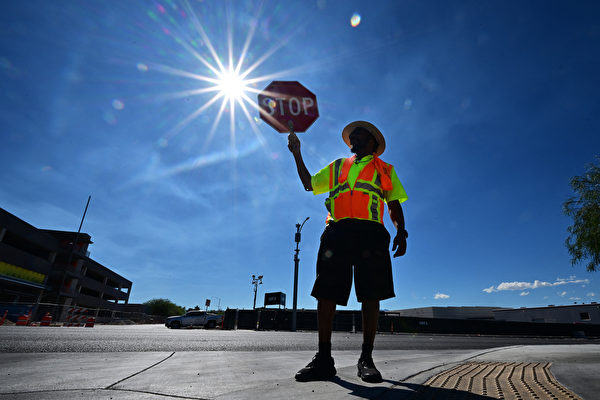Next week, the weather in most parts of the United States is expected to continue warming up, with the Midwest and Northeast regions reaching dangerously extreme high temperatures, prompting authorities to issue warnings and urge people to immediately make plans to ensure their safety.
Over the weekend, a heatwave has already caused temperatures to rise in many Southern states, with nearly 61 million Americans receiving high-temperature warnings or advisories as of Sunday morning, June 16.
Last week, the heatwave hit the Southwest earlier than usual, with temperatures reaching triple digits in places like Phoenix. By 5 p.m. on Saturday, temperatures in Arizona had climbed to 111 degrees Fahrenheit. By the end of the day, temperatures had further risen to 112 degrees. The National Weather Service in Phoenix reported that the reading was 7 degrees higher than the average temperature recorded on June 15 of previous years (105 degrees), but still below the historical high of 115 degrees recorded in 1896 and 1974. Last year, 645 people died in Phoenix due to high temperatures.
According to the National Weather Service, the next heatwave will intensify in the Midwest on Sunday before spreading eastward, with some areas likely experiencing extreme high temperatures. The heatwave could last for a week, with many places experiencing high temperatures persisting into the weekend. Some regions may also experience heat domes, where hot air is trapped by the atmosphere.
Areas from Texas to Maine are expected to experience extreme high temperatures with little to no relief at night according to the National Weather Service’s high-temperature risk map. The latest forecasts from the Weather Prediction Center indicate that extreme high temperatures on Sunday will quickly spread eastward from the Plains states and reach the Great Lakes and Upper Ohio Valley on Monday, followed by the Northeast on Tuesday.
Temperatures in the mid-Atlantic and New England regions are forecasted to reach over 90 degrees Fahrenheit.
Meteorologists predict that high temperatures in the Ohio Valley and Northeast could break daily or even monthly temperature records, with temperatures feeling as high as 105 degrees in some areas.
The extreme temperatures associated with the heatwave can make everyone uncomfortable. When combined with high humidity, direct sunlight, stagnant air, and poor air quality, high temperatures can become a health issue.
Some groups are more at risk of heat-related illnesses than others. Outdoor workers and athletes face a greater risk compared to office workers because they are more exposed to high temperatures. Other groups may be affected by high temperatures due to age or poor health conditions, or because they lack resources to adapt or recover.
Groups most vulnerable to the effects of high temperatures include but are not limited to: children, the elderly, homeless individuals, those with pre-existing medical conditions, people with disabilities, outdoor workers, emergency responders, incarcerated individuals, low-income communities, pregnant women, athletes, and more.
Identifying specific factors that increase certain groups’ risks provides a way for people to reduce exposure and vulnerability through adaptive actions. In some cases, simply raising awareness of the health risks posed by extreme high temperatures can encourage individuals to take adaptive actions, such as seeking indoor shelter or heading to cooling centers.
The human body functions optimally at 98.6 degrees Fahrenheit (37 degrees Celsius). When it overheats and becomes dehydrated, the blood thickens. The heart must work harder, and other organs may be at risk of severe damage. The body has mechanisms to release excess heat – the most obvious being sweating. However, this method may not be as effective, especially in high humidity where sweat cannot evaporate.
Experts warn that if heat-related illnesses are not detected and treated early, they can be fatal, often starting with muscle cramps or spasms. This can lead to heat exhaustion and heatstroke.
Symptoms of heat exhaustion may include profuse sweating and fatigue; weak pulse; cold, pale, clammy skin; as well as headache, dizziness, nausea, and fainting. If such symptoms occur, the individual should be moved to an air-conditioned place and given sips of water. Loosen or remove their clothing.
According to the Centers for Disease Control and Prevention in the United States, an estimated 1,220 people die from extreme heat each year. The center emphasizes in its heat safety guidelines that all heat-related illnesses and deaths are preventable.
It’s crucial to drink enough water to prevent heatstroke. The general recommendation is to drink about 3/4 gallon of water per day per person, although individual needs may vary.
You can check if you are consuming enough water by observing the color of your urine. Dark yellow urine may indicate dehydration.
Avoid sugary, caffeinated, and alcoholic beverages.
If you sweat a lot, combine water intake with snacks or sports drinks to replenish lost salt and minerals due to sweating.
If you have health issues or are taking medication, consult your doctor on how to prepare for high temperatures.
Relying solely on electric fans during extreme heat is not sufficient. When temperatures soar above 90 degrees, fans may not effectively prevent heat-related illnesses. Taking a cool shower or bath, or heading to an air-conditioned place, is a better way to cool down.
Spending a few hours each day in an air-conditioned environment can help prevent heat-related illnesses.
Ensure that your air conditioning is in good working condition.
If you don’t have air conditioning or experience a power outage, seek out places that remain cool. Public libraries, shopping malls, or public cooling centers are good options – plan how to get there.
Local governments or community groups may provide additional resources.
Ensure you have enough lightweight, loose-fitting clothing to wear.
Establish a support team consisting of people who can help you and whom you can help. Stay in touch with them regularly to ensure everyone’s safety.

